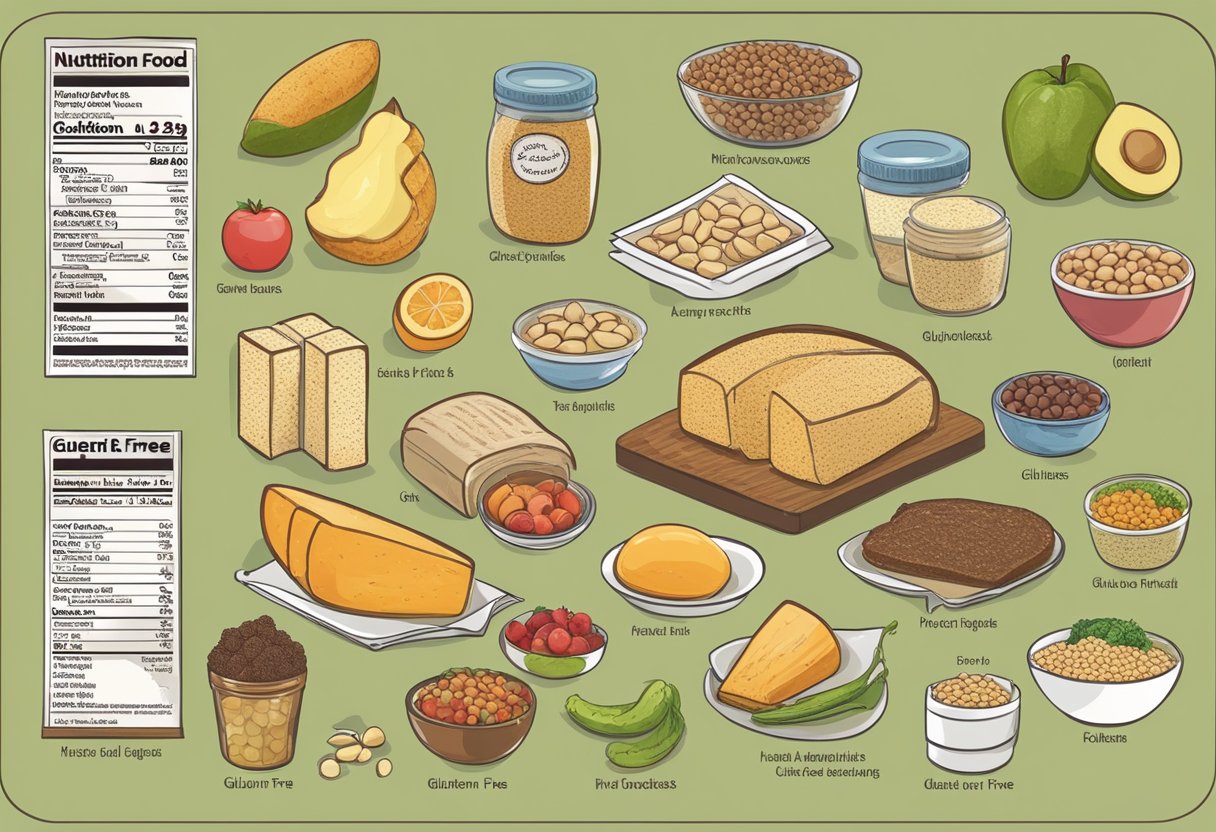The landscape of food options for individuals with celiac disease or gluten intolerance has transformed dramatically over the years. Initially faced with scant alternatives to foods containing gluten, the market has seen a burgeoning growth in gluten-free products. This shift mirrors the rising awareness of celiac disease—a chronic, autoimmune disorder in which ingestion of gluten leads to damage in the small intestine—and the recognition of non-celiac gluten sensitivity by the medical community. As knowledge about these conditions has spread, so has the demand for gluten-free food choices, leading to an ever-expanding array of dietary options that cater to this specific health need.

The proliferation of gluten-free foods has evolved from basic substitutions to a diverse range of high-quality products, paralleling mainstream food trends, including the popular Mediterranean diet. With the advancement in food technology and an increased focus on nutrition, the foods now available are not just about eliminating gluten but also about incorporating wholesome, naturally gluten-free ingredients such as fruits, vegetables, legumes, nuts, seeds, fish, and lean meats, which are staples of the Mediterranean diet. This culinary shift not only supports those with specific dietary restrictions but also offers health benefits that are attracting a broader audience.
Key Takeaways
- Gluten-free options have vastly improved in response to increased awareness of celiac disease.
- Advances in gluten-free products have aligned with the wholesome principles of the Mediterranean diet.
- Nutritional quality and variety have become focal points in contemporary gluten-free food development.
Table of Contents
Understanding Gluten and Celiac Disease
In examining the emergence of gluten-free options, it is crucial to understand gluten’s role and its link to celiac disease—a serious autoimmune disorder.
What Is Gluten?
Gluten is a family of proteins predominantly found in grains such as wheat, barley, and rye. It acts as a binder that gives baked goods their structure and chewiness. Foods within a Mediterranean diet, such as pasta and traditional breads, commonly contain gluten, which is why gluten-free alternatives are significant for those avoiding this protein.
Celiac Disease Fundamentals
Celiac disease is an autoimmune disorder where the ingestion of gluten leads to damage in the small intestine. This reaction is a result of the body’s immune system responding to gluten as if it were a threat. Over time, this immune response can damage the intestinal lining, resulting in increased intestinal permeability, malabsorption, and a range of symptoms from digestive issues to neurological effects. Adhering to a strict gluten-free diet is the cornerstone of managing celiac disease, making the evolution of gluten-free food options, including those within a Mediterranean diet context, vital for those affected.
The Rise of Gluten-Free Diet
The popularity of gluten-free diets has escalated, not just among those with celiac disease but also among people with non-celiac gluten sensitivity and wheat allergy. These diets are rich in alternative grains and meals that conform to nutritional needs while omitting gluten.
Gluten-Free Diet Essentials
A gluten-free diet eliminates all sources of gluten, which is a protein found in wheat, barley, and rye. Essential to those with celiac disease, this diet requires meticulous reading of food labels to avoid gluten contamination. Gluten-free products have become more accessible, with options such as quinoa and buckwheat gaining popularity as nutritious alternatives rich in protein. These products often integrate into a Mediterranean diet, utilizing ingredients like fresh vegetables, fruits, legumes, nuts, and seeds, that naturally do not contain gluten.
- Key Nutrients: Iron, calcium, fiber, thiamin, riboflavin, niacin, and folate
- Common Alternatives: Rice, corn, potatoes, and gluten-free oats
Non-Celiac Gluten Sensitivity and Wheat Allergy
Individuals with non-celiac gluten sensitivity experience symptoms similar to celiac disease without the intestinal damage. They benefit from a gluten-free diet to alleviate discomfort. Those with a wheat allergy must avoid wheat but can tolerate gluten from other grains. Nutrition is critical for these individuals as well; hence, gluten-free Mediterranean staples, such as olive oil, fish, and lean meats, provide essential fatty acids and proteins without the risk of gluten exposure.
- Symptoms: Bloating, abdominal pain, headaches, fatigue, and brain fog
- Management: Strict gluten-free diet and nutritional balance with a focus on Mediterranean diet components
Gluten-Free Food Labeling and Regulation
In the United States, the gluten-free market has grown considerably, leading to stringent regulations aimed at ensuring the quality and safety of gluten-free products for consumers.
Understanding Gluten-Free Labels
Gluten-free labels are critical for individuals following a gluten-free Mediterranean diet, as they rely on clear, accurate labeling to avoid gluten that can be found in common ingredients such as wheat, barley, and rye. A product labeled as “gluten-free” must adhere to specific standards set by the U.S. Food and Drug Administration (FDA). According to the FDA’s regulation, gluten and food labeling, a food that is labeled as “gluten-free,” as well as “free of gluten,” “no gluten,” or “without gluten,” must contain less than 20 parts per million (ppm) of gluten. This standard helps consumers of gluten-free products to make safe and informed food choices.
Regulations and Certification
Regulations for gluten-free products in the market are designed to maintain a high standard of quality. In 2014, the FDA set forth the gluten-free food labeling rule to define what constitutes a gluten-free product and to protect consumers with celiac disease and other gluten-related disorders. While certification is voluntary, many manufacturers seek gluten-free certification from third-party organizations to underscore their compliance with the FDA’s regulations and to instill further confidence among consumers. These certifications indicate that gluten-free products have undergone rigorous testing to meet the required gluten thresholds and that facilities adhere to strict production standards to avoid cross-contamination.
Advances in Gluten-Free Products

The progression of gluten-free products over time demonstrates a significant diversification in options, alongside enhancements in both their culinary quality and nutritional content.
From Early Gluten-Free Options to Today’s Varieties
Gluten-free food choices have evolved immensely from the basic and often unappetizing offerings available in the past. Earlier gluten-free products, typically bland and limited in variety, have given way to a broader spectrum that now includes a range of bakery items and pastas, aligning closely with a Mediterranean diet. For example, gluten-free pasta now comes in forms that maintain the traditional taste and texture of their wheat-based counterparts, which is a notable shift from the past where gluten-free options often fell short in comparison. These transformations have made adherence to a gluten-free Mediterranean lifestyle significantly more pleasant and diverse.
Innovation in Gluten-Free Foods
Innovation in the realm of gluten-free products has been a driving force behind the improvements in texture and taste that consumers now enjoy. Pioneering techniques in food science have led to developments such as enzyme treatments and high-protein flour alternatives, which have notably enhanced the eating quality of gluten-free bread and pastries. This culinary advancement has not only broadened choices for those with celiac disease or gluten sensitivity but also for health-conscious individuals seeking to integrate gluten-free options into their Mediterranean dietary patterns. Such innovations reflect an ongoing commitment to both variety and enhanced sensory experiences in gluten-free food production.
Nutritional Considerations for Gluten-Free Diets
A gluten-free diet must be carefully managed to ensure nutritional adequacy and support weight management. Gluten-free products often lack certain nutrients found in their wheat-containing counterparts, so individuals must seek these nutrients through alternative sources.

Ensuring Nutritional Adequacy
Individuals adhering to a gluten-free Mediterranean diet should focus on including a variety of nutrient-dense foods to compensate for the potential lack of vitamins, minerals, and fiber that are often associated with traditional gluten-containing grains. Key components of this diet include:
- Fruits and Vegetables: Abundant in gluten-free Mediterranean meals, providing antioxidants, fiber, and several vitamins.
- Gluten-Free Whole Grains: Options such as quinoa, and amaranth are rich in B vitamins and minerals.
- Legumes: These offer additional fiber, protein, and minerals like iron and calcium.
- Nuts and Seeds: Healthy fats, protein, and minerals like magnesium are plentiful in these foods.
Incorporating these foods can help maintain a balanced diet. For specific nutrients, Nutritional Considerations of the Gluten-Free Diet suggests that B vitamins and iron are critical and may be lacking in a gluten-free diet.
Managing Weight and Health on a Gluten-Free Diet
A common misconception is that a gluten-free diet automatically leads to weight loss. However, weight management on a gluten-free diet involves mindful eating and a focus on whole, unprocessed foods. Processed gluten-free products can be high in calories and sugar while low in fiber. For healthy individuals seeking weight management:
- Portion Control: Be aware of portion sizes, especially with gluten-free packaged foods.
- Whole Foods: Emphasize fresh fruits, vegetables, and lean meats typical of a Mediterranean diet.
- Healthy Fats: Include sources like olive oil and avocados that provide satiety and beneficial nutrients.
Within The Gluten-Free Diet for Celiac Disease and Beyond, it’s emphasized that a well-planned gluten-free diet can support overall health while also catering to weight management goals.
By incorporating the variety and balance of a Mediterranean diet while considering the unique aspects of gluten-free foods, nutritional adequacy and healthy weight can be achieved and maintained.
Gluten-Free Foods in Everyday Life

Gluten-free foods have permeated daily life, making it easier for individuals with celiac disease or gluten sensitivity to maintain their dietary needs. Restaurants have adapted menus, and staple food options at grocery stores now commonly include gluten-free variants.
Gluten-Free Foods in Restaurants and Social Settings
Many restaurants have embraced the need for gluten-free options, often offering a variety of dishes that cater to this specific requirement. Gluten-free bread and pasta have become more commonplace, enabling those who adhere to a gluten-free diet to enjoy a dining experience similar to that of non-restrictive diets. Mediterranean restaurants, in particular, offer naturally gluten-free foods such as grilled meats, salads, and rice dishes, emphasizing olive oils and fresh vegetables.
Examples of Gluten-Free Mediterranean Options in Restaurants:
- Appetizers: Olives, stuffed grape leaves, hummus (without wheat-based pita)
- Main Courses: Grilled fish, chicken kebabs, lamb with rice
- Sides: Gluten-free bread substitutes, quinoa tabbouleh
The Role of Gluten-Free Foods as Staple Diet
The grocery store landscape has also changed, with shelves now stocking an abundance of gluten-free products. Individuals can easily find staple foods like gluten-free bread and pasta made from rice or corn, alongside Mediterranean staples like feta cheese, tomatoes, and cucumbers. These items have become integral in the daily diet of those avoiding gluten and are essential in a gluten-free Mediterranean meal plan.
Common Gluten-Free Staples Found in Grocery Stores:
- Breads: Made with alternative flours such as almond, coconut, or chickpea
- Pastas: Varieties include those made from lentils, chickpeas, or brown rice
- Grains: Quinoa, millet, and amaranth serve as excellent gluten-free grain options
This influx of gluten-free food options has not only provided safe and enjoyable ways for people to maintain their diets but has also inspired a new appreciation for the diverse and flavorful offerings of Mediterranean cuisine.
Frequently Asked Questions
Adopting a gluten-free diet has been linked to various health benefits and potential risks. This section addresses common inquiries related to the health implications, historical evolution, and scientific findings concerning gluten-free food options.
What are the health benefits associated with adopting a gluten-free diet?
Individuals with celiac disease or gluten sensitivity may experience substantial health improvements, including reduced inflammation and digestive discomfort, upon eliminating gluten from their diet. For those with these conditions, a gluten-free diet is essential.
How has the popularity of gluten-free diets changed in recent years?
The demand for gluten-free products has burgeoned, with market growth attributed to greater awareness of celiac disease and the perceived overall health benefits of gluten-free foods. This increased popularity has led to a more diverse and accessible range of gluten-free products.
Are there any risks or negative side effects linked to following a gluten-free diet for non-celiac individuals?
Non-celiac individuals may face nutritional deficiencies if adopting a gluten-free diet without proper dietary planning. It’s crucial to ensure adequate intake of fiber and essential vitamins, which are abundant in grains that contain gluten.
What are the long-term effects of maintaining a gluten-free diet?
For those diagnosed with celiac disease or non-celiac gluten sensitivity, long-term compliance with a gluten-free diet can lead to significant health improvements and a lower risk of associated complications. Research is ongoing to understand the full scope of long-term effects, particularly in individuals without celiac disease.
Have there been significant scientific studies on the impact of gluten-free diets on health?
There has been increasing scientific interest in understanding the effects of gluten-free diets on health. Studies focus on quality of life, nutritional sufficiency, and the diet’s role in managing celiac disease and other gluten-related disorders.
What historical developments have influenced the availability of gluten-free food options?
The development of gluten-free options has been influenced by the recognition of celiac disease and the subsequent demand for appropriate food products. Improved diagnostic methods and heightened public awareness have played crucial roles in the history of the gluten-free diet, contributing to the variety and availability of gluten-free alternatives.



